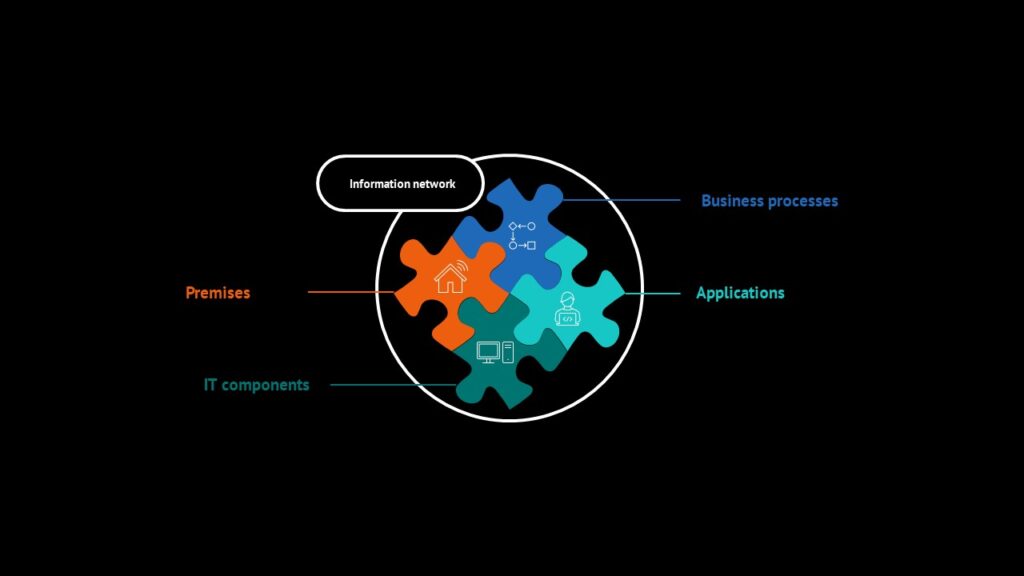Architecture-driven
IT-Security
Comprehensive protection for your company
There are no locks in the digital world - only strong defences.
Information security is essential to ensure the comprehensive protection of companies. Legal requirements such as NIS-2, GDPR, DORA and KRITIS stipulate the implementation of various requirements in the area of information security.
Recognising optimisation potential – the architecture-driven approach
The architecture-driven IT-Security approach pursues a holistic, structured approach in which optimisation potential is discovered as a natural consequence of a clearly defined enterprise architecture.
Comprehensive protection against cybercrime
The architecture-driven IT-Security approach builds a comprehensive security strategy that not only recognises vulnerabilities, but also proactively prevents them and ensures systematic protection.
Compliance as an integral component
Compliance is not viewed in isolation, but is consistently integrated into all company processes. This not only ensures compliance with regulations, but also promotes an understanding of the impact on the entire corporate structure.
Architecture-driven certification
Our services
IT-Security maturity check
- Holistic analysis: Comprehensive assessment of the current IT-Security level and identification of vulnerabilities.
- Individual recommendations: Customised measures to improve your IT-Security, tailored to your specific needs and framework conditions.
- Fulfilment of legal requirements: Ensuring compliance with relevant guidelines and laws, such as NIS 2, KRITIS, DORA and GDPR.
- Increasing the level of maturity: Long-term increase in IT-Security standards and improvement of organisational resilience against cyber threats.
Information network
- Comprehensive transparency: Complete and up-to-date overview of all IT assets, processes and their relationships.
- Efficient security strategies: Automated inheritance of security requirements reduces manual errors and increases the efficiency of your security measures.
- Compliance with regulations: fulfilment of international safety standards and legal requirements, which strengthens the trust of customers and partners.
- Risk minimisation: Reduction of security risks through a structured and consistent security architecture.
Security Compliance Tracking
- Coverage of the requirements: Regular reports on the current status of fulfilment of the defined security requirements.
- Measures tracking: Monitoring and reporting on the implementation status of the stored security measures.
Process landscape of IT Security processes
- Process definition: Identification and detailed description of all IT-Security processes.
- Process documentation: Creation of clear and comprehensible process documentation that serves as a reference for your IT and security team.
Architecture-driven certification
Our approach
Our approach utilises synergies between enterprise architecture management, business process management and IT-Security.
We implement aspects of IT-Security directly into your process and application landscape. This approach offers a quick high-level view of all relevant aspects of IT-Security.
The central component of the architecture-driven IT-Security approach is the recording of all protected objects in the information network and their relationships.
All objects worthy of protection are identified and categorised. With this basis, a detailed analysis of the damage scenarios can be carried out in order to recognise potential threats and risks.
Another decisive factor of the approach is the mapping of the protection requirements of the individual target objects. Firstly, the protection requirement categories are defined in order to determine the necessary level of protection for each object. These categories make it possible not only to define the protection requirements individually, but also to inherit them, which leads to greater consistency and traceability of the security requirements. In this way, we ensure that all relevant objects are optimally protected according to their importance.
Example of the procedure in the context of architecture-driven IT-Security
At the beginning, the protection requirement categories are defined in order to ensure a high-quality categorisation of the protection requirement. Categories such as “normal”, “high” and “very high” are defined. The next step is to record the objects, in which all elements to be protected, such as business processes, applications and other critical objects, are systematically recorded.
The damage scenarios are then analysed. This involves analysing typical scenarios that could have an impact on the confidentiality, integrity and availability of the recorded objects. The documentation of this process is crucial in order to clearly and comprehensibly record the results of the protection requirements assessment as well as the assigned categories and justifications.
The defined protection requirements are regularly reviewed and adjusted to ensure that they remain up-to-date and effective even with changes in business processes, technological developments or with regard to new threat scenarios.
Your advantages
In addition to the advantages of the architecture-driven IT-Security approach mentioned at the beginning – such as the discovery of optimisation potential, holistic protection against cybercrime and the integration of compliance as an integral component – this approach offers further decisive advantages.
These include the improvement in market opportunities and the competitive advantage achieved through a long-term and forward-looking security strategy. The approach also ensures greater transparency across company processes by systematically documenting all security measures and their effects.
Another key benefit is the reduction in costs through proactive security measures and the automation of processes, which minimise financial expenditure in the long term. Finally, the architecture-driven approach contributes to risk minimisation by pursuing a sound and continuous security strategy that identifies and averts potential threats at an early stage.
Compared to an audit-driven approach, which is often selective and reactive, these advantages are much more strongly emphasised in the architecture-driven approach. It does not just react to individual vulnerabilities in the short term, but creates a comprehensive, sustainable security architecture that secures and strengthens the company in the long term.
EAM-Tool Services
Find all information on the topic of EAM tool consulting here:
KRITIS
Find all the information you need on the subject of KRITIS and our KRITIS consulting services here:

Dr. Dietmar Gerlach
Head of IT Management Consulting



